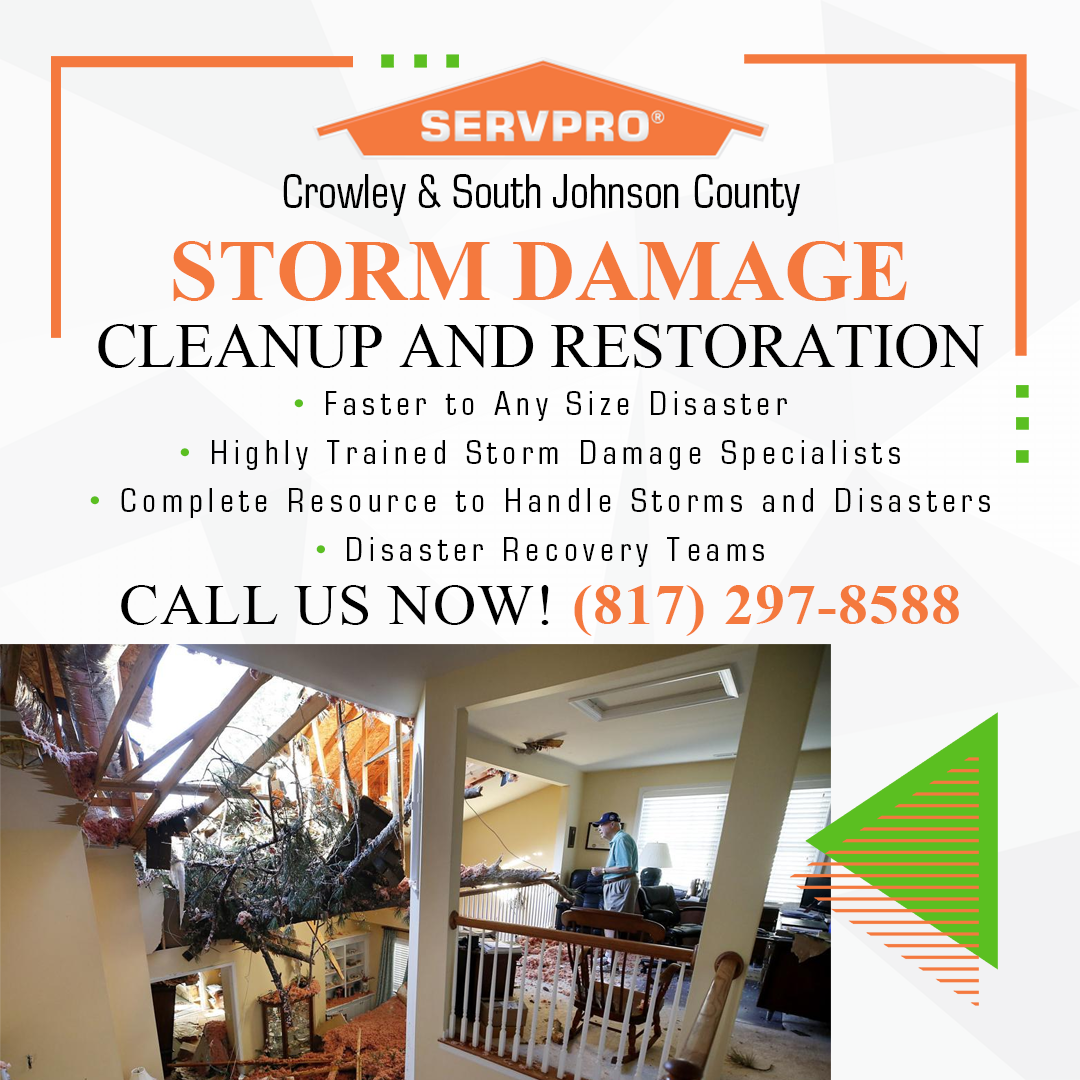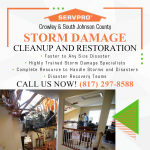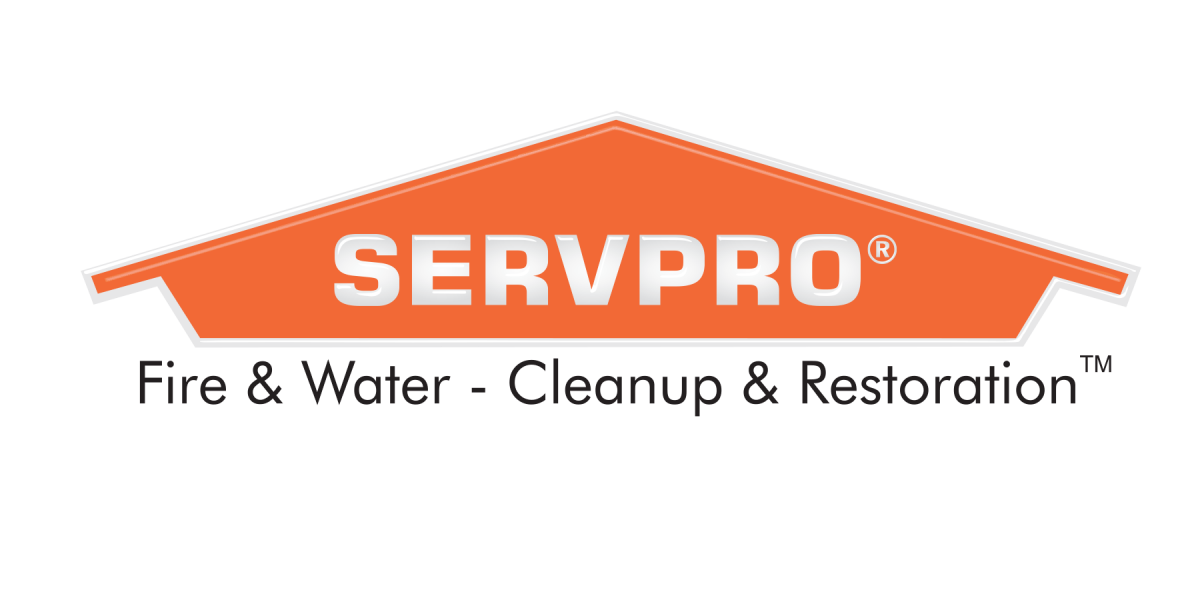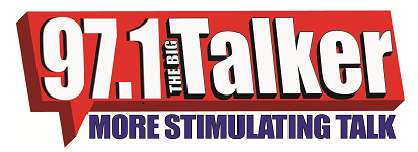SERVPRO of Crowley & South Johnson County is the premier flood and storm damage restoration company in the region. The team’s experience, training, certifications, customer service, and attention to detail demonstrate to the community that a call to SERVPRO is the best call. The storm damage restoration professionals will respond faster to any size disaster, provide industry-standard services, and restore the home or business to its pre-damage condition.
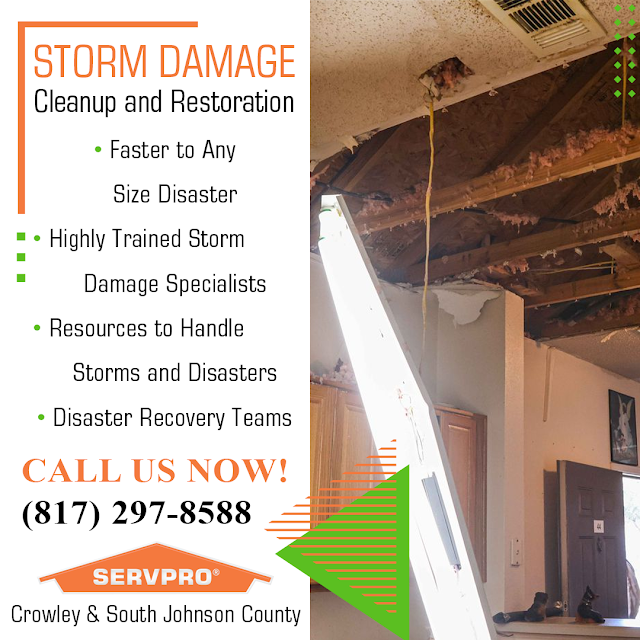
How Homeowners Can Combat Mold Growth After Storm Damage and Flooding
When a water or flood damage disaster strikes, the likelihood of a major mold infestation increases dramatically and must be considered when hiring a property damage restoration company to remove the water and repair the affected areas of the home or business. The restoration company should also have the knowledge, equipment, and training to effectively mitigate mold risk and remediate any mold damage.
These five strategies can help homeowners prevent mold growth after flood and storm damage in Crowley, TX.
Tip #1: Know what signs of mold to look for.
One of the first signs of mold is a musty, earthy smell in areas of the home that have been affected by water intrusion or excessive moisture. Mold needs moisture, warmth, darkness, and food — organic matter such as wood, sheetrock, natural fabrics. Actively growing mold gives off microbial volatile organic compounds (MVOCs), which account for the earthy smell.
Look for signs of mold. Mold can be many different colors, including black, white, green, grey, yellow, or brown. Depending on the type of mold, it may exhibit a cottony or velvety texture. Avoid disturbing the mold if at all possible. If there are no immediately obvious signs of mold, take the following steps:
- Seek out the strongest scent of mold. At the location where the mold smell is most prominent, scan closely for visible signs of mold growth.
- Visually inspect walls, carpeting, throw rugs, other flooring materials, magazines piled on the floor, and clothing and shoes in closets near the water intrusion. Water stains, bubbling paint or peeling wallpaper signal the presence of water and the necessary conditions for mold growth. Look for mold in these areas.
- Check under cabinet sinks.
- Look and feel for moisture such as water stains and discoloration on the ceilings, walls, and floors. If moisture is detected, look for mold growing on or near the wet surface.
Tip #2: Check for alternate sources of water damage.
The initial flood or storm damage incident may have led to other sources of water damage. Flooding may have damaged or cracked a pipe, causing it to leak. If gutters and downspouts were damaged by severe weather and were not promptly repaired, water could be pooling around the foundation and seeping into the crawl space or basement, leading to a mold infestation. Flooding and severe weather can set off a cascade of water intrusion events involving roof vents, shingles, siding, windows, and the chimney.
Tip #3: Call a storm damage restoration specialist as soon as it is safe to do so.
When water damage restoration is needed, shaving minutes off the response time contributes directly to preventing advanced secondary water damage such as mold infestation, especially when carpeting, furniture, upholstery, personal belongings, clothing, electronics, and important documents are involved. A reputable flood and storm damage restoration company is available 24/7 and will immediately dispatch a crew to the scene, whether it is 3 pm in the afternoon or 3:00 am in the morning.
Tip #4: Make sure that the damage restoration company is skilled in content restoration.
Enlisting the services of a property damage restoration company that does not specialize in restoring water-damaged personal belongings could result in mold issues in the future. It could also lead to the ruin of precious keepsakes, priceless artwork and photographs, designer clothing and footwear, and important documents. A “restore” rather than “replace” approach will, in many cases, save money for the homeowner while preserving irreplaceable heirlooms.
- Does the company offer a wide range of cleaning techniques for different items and various types of damage? Examples include dry cleaning, wet cleaning, spray-and-wipe cleaning, foam cleaning, abrasive cleaning, and immersion cleaning.
- Does the company offer organized, efficient, and thoroughly documented move-out and pack-out services for homes or businesses that have sustained severe damage and need extensive restoration or cleaning services? This service speeds up the restoration process and protects items from further damage while storing them in a secure location.
- Is the restoration company able to provide cleaning and inspection of water-damaged electronics by a qualified electronics technician?
- Do the storm and water damage restoration specialists have the training, certifications, and equipment for document and photograph drying? A trustworthy company will admit that not all documents can be restored to pre-damage condition. Competent document restoration specialists will be able to save most documents in a readable, usable form using a combination of techniques such as air drying, dehumidification, freezer drying, vacuum freeze-drying, and vacuum thermal drying.
- Does the restoration company offer contents claim inventory services? This service provides a detailed list, including digital photos and barcoding, of all personal belongings involved in the restoration process. Assistance with the burden of proof for claims brings the homeowner peace of mind in the midst of turmoil and stress.
Tip #5: Avoid spreading mold spores or tracking black water throughout the structure.
Be attentive to what clothing was worn when dealing with the storm damage, and remember to wash contaminated clothing separately. Tracking sewage-contaminated water and mud throughout the home expands a one- or two-room mishap into a whole-house disaster.
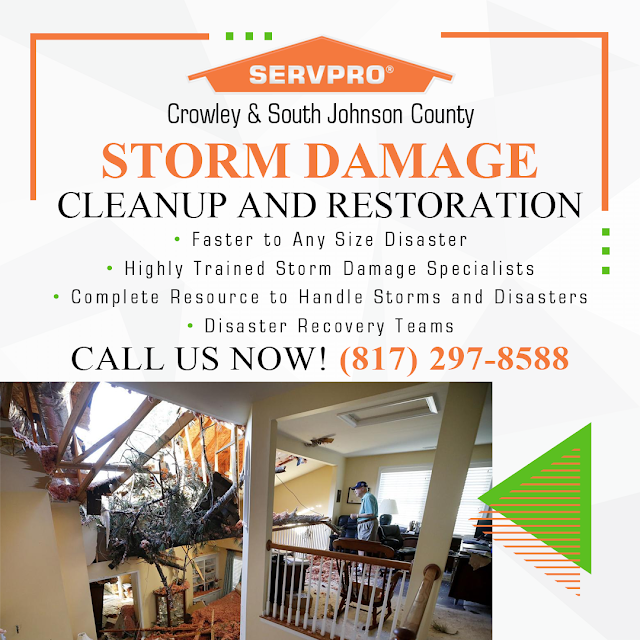
Following these five tips can reduce the likelihood of mold damage and the loss of personal belongings after a storm or flood damage disaster. As a locally owned and operated business, SERVPRO of Crowley & South Johnson County can respond quickly to a storm damage disaster no matter what time of day or night the call comes in requesting emergency damage restoration services.
For more information about Cresson, TX, storm damage restoration, contact the office by phone at (817) 297-8588 or by email at office@servprocrowley.com.
